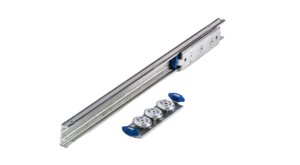Sliding rails or guide rails are often present around us without our noticing, especially in the professional environment. The purpose of a guide rail is not to extend, but to guide linearly. Unlike telescopic slides, which can be fitted with several elements to offer greater or lesser extension. Sliding rails, linear guides or linear guide rails are synonyms used to define guide rails.
1-What applications can guide rails be used for?
Sliding rails have become an indispensable part of the industrial sector. In addition to being long-lasting, sliding rails are made from solid materials. Guide rails can be made of steel, aluminium or stainless steel to resist corrosion.
All our rails are supplied with RoHS-compliant anti-corrosion treatment. Standard treatments are suitable for most applications. Additional surface treatments are available on request.
In terms of applications, guide rails are very much in evidence around us. They are widely used for sliding doors in industrial applications. One of the advantages of sliding tracks is their adaptability. In fact, they come in a wide range of shapes and sizes to suit even the smallest of environments. For longer lengths, a sliding track can be up to 2 meters long, and in some cases up to 3 meters.
Guide rails are also very easy to maintain if cleaned and lubricated regularly. The load-bearing capacity of sliding rails depends on the type and number of runners you install. Runners can withstand loads ranging from 5 kg to 600 kg per runner, whilst maintaining smooth, silent running.
2-What types of guide rails does Chambrelan offer?
Chambrelan offers two types of guide rails for very different uses: guide rails with ball bearings and guide rails with roller bearings. These rails can be accompanied by one or more runners, depending on how you want to use them. The number of runners will also determine the load you can support with your sliding track. However, other factors also need to be taken into account, such as the material, length and manufacturing process of the sliding track or guide rail.
a) Guide rail with ball bearings
Ball bearings ensure smooth, frictionless sliding, while combining strength, flexibility and precision. The number of ball-bearing runners to be installed on this type of sliding track will depend on the length of the track and the load you wish to support.
Ball-bearing guide rails are available in a range of materials to suit all types of project. For example, aluminium rails are very useful for light loads, adapting to small spaces. On the other hand, steel and stainless steel sliding rails are designed for heavier loads, up to 3,000 kg.
Guide rails must be installed in a dust-free environment, to preserve the lubrication of the recirculating ball bearings. Dust accumulation on the rail can lead to loss of lubrication of these components. Even in conditions where it is difficult to maintain a perfectly clean environment, increasing the frequency of lubrication helps to prolong the life of the device.
b) Guide rail with roller runners
Like ball-bearing glides, roller glides offer a number of advantages when installed on a sliding rail. The main advantage is that the roller in the center of the rail is adjustable. This means you can adjust the play and displacement of your guide rail as you assemble it. The rule doesn’t change for guide rails with roller runner: it’s the number of runners that increases the load the rail can support.
Our range of guideways with roller runners starts at 18 mm in height (ultra-compact guideway) and goes up to 67.3 mm (Super Heavy). As the rollers runners on our track are self-greasing, there’s no need to add grease to the guideway. This makes maintenance of this type of product all the easier.
For polluted environments, some of our roller runners can be fitted with wipers to push a possible foreign body back into our guide rail. Scrapers limit the risk of a skid jamming in a guideway. Another solution is to select a guideway with “prismatic” geometry. This type of guideway is perfectly suited to polluted environments. Its shape prevents the accumulation of foreign matter on the raceways.
Prismatic guideways with roller runners can be bent. The bending radius and hole spacing of our guide rails are made to measure.
When using our steel guideways with roller runners, we recommend a surface treatment to harden the raceways. This treatment will increase the product’s lifespan. As with the entire Chambrelan range, different anti-corrosion treatments are available for our guide rails.
Sliding rails with roller runners are mainly used in aeronautics, railways, industrial machinery, vehicle fittings and the medical sector. It’s also worth noting that, for guideways with roller runners, edge-mounting increases the rail’s load-bearing capacity, unlike flat-mounting.
3) What are the maintenance recommendations for your linear guides?
Linear guides are delivered pre-lubricated from the factory. To ensure optimum service life for CHAMBRELAN guidance systems, we recommend regular maintenance of your telescopic slides and linear guides, with cleaning and lubrication. This is particularly important in case of intensive use.
Do you have a question or need about guide rails? Please do not hesitate to contact our teams so that we can advise you on your project.






